Diretório para todos os estilos em estado de Estresse e de Calma
Esta página contém orientações para todos os cinco estilos em estado de Calma e de Estresse. Use essas informações para obter uma visão sobre os estilos que não foram abordados em seu relatório de pontuação ou para aprender como trabalhar de forma mais eficaz com outras pessoas ao seu redor, cujos estilos de conflito você agora é capaz de reconhecer.
![]()
ESTILO COMPETITIVO EM ESTADO DE ESTRESSE
|
When You Favor Directing in StormThis suggests that when stress and tension are high you press ahead with your own agenda and focus on what you feel needs to be said or done, without being distracted by or conceding to the wishes of others. Directing has particular strengths and weaknesses you should be aware of. |
Directing has Important Uses
Wisely used, Directing enables you:
- To assert yourself and be heard, even in difficult circumstances.
- To be decisive and take action in the face of challenge.
- To take a stand on principles or to defend others in need of protection.
- To exercise leadership and authority, to give instructions, set limits, and coordinate.
- Directing is necessary for certain circumstances: A ship's captain, an emergency room doctor, a traffic officer in an intersection, or the leader of a youth group on a field trip are examples of people who need to be clearly in charge and not easily distracted from their mission even when others are emotional. People scoring high in Directing often have an unusual ability to decide, act, take charge, coordinate, do challenging work, protect others, and persist rather than give up or give in when things are difficult.
But Don't Over-use It
Although Directing has important strengths, use this forceful style with care. Ignoring the wishes of others is necessary at times, but over-use of Directing is likely to bring:
- Frequent conflict with peers and superiors.
- Damage to relationships important to you.
- Low morale, resentment, discouragement, or depression among those you live or work with. Those living or working with someone who uses Directing excessively are at risk for depression. They often learn to Avoid or Harmonize in order not to be in constant tension with the Director, but the disappointment and frustration accumulate.
- Bossiness and contentiousness between those who look up to you if your conduct sets the standard for how to behave.
- Reduced access to important information, processes, and perspectives. If others decide it's too difficult to work things out with you and reduce their interaction with you, your ability to be informed will go down. Your ability to influence and lead may also go down.
Take Steps to Maintain Balance with Directing
You can do things to help you experience more benefits of wise use of Directing and fewer costs of overuse:
- Increase your context awareness. Directing is a gift where strong coordination and direction from one person are essential. It's a requirement in part of life, not all of it. Where equality and consultation are expected, others resent over-use of Directing. Recognize this and you will avoid the Achilles Heel of this style. Read the settings you are in and adapt accordingly. When in doubt, dial back on Directing instincts. You can ratchet up your assertiveness later if required, whereas relationships may never recover from the resentment you will cause if you misjudge circumstances and impose yourself inappropriately.
- Expand your skills in other styles and do not rely more than necessary on Directing. In particular, master the skills of the Cooperating style, which like directing is assertive, but adds relational skills. For example....
- Hone skills in listening well. Being a good listener rarely detracts from the ability to act decisively when necessary and the info gain may increase your ability to make good decisions. If you are a good listener, others are more likely to experience you as having strength tempered by wisdom rather than as simply pig-headed.
- Work on relationships. Look for opportunities to support, affirm, appreciate others. Read the section on Support Strategies for each style for specific suggestions on how to support each of the other styles. The Support Strategies for Cooperating, Harmonizing, and Avoiding will be especially useful info for you, for they guide in doing things that many high-scoring Directors never realize others need.
- Be in charge in ways that respect and honor others. This is an art that requires practice. Pay close attention to your tone of voice and body language, for a great deal is communicated by these. Be strong and supportive towards others.
- Consult with others where possible. Invite input from others and incorporate as much as you can into your work. Doing this does not remove your authority to make final decisions. The skills described above take time and effort to develop, but you can choose to start consulting more often immediately. Remember, consulting is not negotiating. View it as a time to listen, learn, and gather input (about both the issues and about how people are experiencing the discussion process), not as a time to persuade others. You won't always be happy with what you hear, but that's sort of the point, isn't it?
Support Strategies for Directors

With someone who prefers Directing as a conflict style, others are more likely to get a favorable response if they:
- Display commitment to task. People who score high in Directing are task-oriented. They appreciate when others are task-oriented too and focus on getting the job done.
- Be action oriented. Directors get frustrated with inaction; they want to make a decision and act.
- Provide information and updates frequently. Directors value information so they know what is going on.
- Speak up. Many Directors function better when others speak up. In appropriate settings, provide information about your views and intentions; don't go silent.
- Show commitment to the discussion process. Directors want to know that things are going to get resolved. Don't walk out or withdraw without explanation. If you need a break from intense conversation, it's probably fine, so long as you use a two-step approach: 1) Explain that you need a break and will come back at a specific time (in an hour, a day, a week, etc.) to continue the discussion; 2) Return at the agreed time for further conversation. This addresses the Director's need to feel assured the discussion will in fact take place.
- Separate task activities and relationship-building. Do relationship-building in times, places, and ways that don't hinder getting the task done. Then Directors are more likely to join in with enthusiasm.
- Show a positive, problem-solving attitude. Don't just tell a Director you have a problem. Make it clear that you want to work with him or her to solve it. Show that you are willing to put initiative into helping solve it. Communicate what you want rather than dwelling on what you don't want.
If any of the ideas above appeal to you, multiply their value by discussing them with a trustworthy person with whom you live or work.
ESTILO COLABORATIVO EM ESTADO DE ESTRESSE
|
|
Cooperating has Important Uses
Strengths associated with wise use of this style include:
- Confidence and optimism. People who favor Cooperating have unusual confidence that "we can work things out". Their hopefulness can be a gift to others.
- Leads to strong teams. Cooperating is committed to both task and relationship. Partners and teams who use it well become strong units; the work gets done in a thorough way and the people involved enjoy good relationships.
- Innovation and creativity. Solutions that nobody had thought of before often emerge in the intense, interactive, respectful probing typical of the Cooperating style.
- Skill at talking things through. It's impossible to use Cooperating well without strong skills for talking things through. Though they are not always even aware they have them, people good at Cooperating often possess these skills, learned from the modeling of parents or teachers, by trial and error, or training in conflict resolution or communication.
- Endurance. People who score high in Cooperating often have unusual stamina for talking things through. They know it takes time to find solutions that work well for everyone. They have the confidence to present their own views and the courage to keep talking even when others disagree. They help others not to lose hope in the possibility of finding peace even in the midst of big differences.
- Personal growth. Since they engage deeply, people who use Cooperating a lot are constantly exposed to new ideas and perspectives. They learn and grow from this and tend to develop confidence in their abilities and optimism for solving problems. Their confidence and their attitude towards others encourages similar growth in those around them.
- Trust between people. When teams or groups use Cooperating successfully, confidence in each other grows. The feeling is: We can work through our issues.
But Don't Over-Use It
Though it has wonderful strengths, like all styles, Cooperating has its limits. Overuse of Cooperating is likely to bring:
- Failure to get other more important things done. Not all conflicts merit the intense time and effort required to Cooperate. Applied to too many trivial issues, Cooperating backfires, as people weary of "too much processing".
- Increased conflict and misunderstanding, if used without consideration of status. This style involves being "up front" about what you want. A junior secretary should not use it with the company CEO, nor should a CEO assume others will feel free to use it with him or her. Cooperating can be tricky when power and status are unequal.
- Discouragement, low morale, sense of failure, if attempted without realistic awareness of the time and skills required on difficult issues.
- Exhaustion and burnout. People who over-use Cooperating may run out of time and energy for all the intense conversations that result. No matter how good the intention or skill, constant intense problem-solving with others has costs. Sometimes it is necessary to protect your core mission by limiting your use of Cooperation.
- A bad name for "conflict resolution", "dialogue", "peace processes". If Cooperating is pursued too long with an opponent who takes an unyielding Directing or Avoiding stance, it may create "evidence" that talk and problem-solving efforts don't work. Yes, a patient Cooperating approachoften brings forth a Cooperating response in others, but it does not always do so. If you persist anyway and hold out unrealistic expectations, people may lose confidence in Cooperating as a useful response. Over-using Cooperating may thus damage the cause of peace.
Take Steps to Maintain Balance with Cooperating
This is a highly constructive but energy-intensive conflict style. You can take special measures so you experience more of the benefits of wise use of Cooperating and fewer of the costs of overuse.
- Expand your use of other styles so you are less likely to over-use Cooperating.
- Choose your battles. Think carefully about which issues, relationships, and situations deserve the time and effort required for Cooperating. If you use it too often you'll run out of time and energy for people and causes you truly care about and you could even be in danger of burnout.
- Consider dynamics of status and power. To the extent inequality is present, use a two-step approach. If you are a higher status person in a given conflict, begin with affirmation or appreciation of the other person. As a lower status person, thank or otherwise acknowledge your senior for being willing to meet to resolve things. Only after these preliminaries should you move to the open discussion typical of Cooperating.
- Pay careful attention to timing and readiness. Recognize when the skills and attitudes required for Cooperating are present, and when they are not. Then choose your response style appropriately. Sometimes it is better to use a different strategy for a while until you or others are ready for Cooperating.
- Do good process design. If the conflict involves numerous people, plan the process together. Usually it it not hard to agree on with whom, where, when, in what sequence things will be discussed. This "agreement on the process" will ease the discussion.
- Monitor the length and intensity of discussion. People who favor Cooperating tend to have more energy for intense discussion than others (with the exception of Directors, who may equal Cooperators in this). Monitor your volume and intensity; offer a break from discussion, or scheduling continuation in a second round.
Support Strategies for Cooperators

With someone who prefers Cooperating as a conflict style, others are more likely to get a favorable response if they:
- Provide good listening. Feeling heard helps all styles, but Cooperators respond particularly well to efforts to structure conversation around listening. Hear them out fully and you are likely to be surprised at how well even an angry Cooperator will listen in response. If you know the skill of "active listening" or paraphrasing, use it.
- Are candid, without being rude or insulting. Most Cooperators respect directness and candor in others so long as it is polite. Saying what you want and need will be appreciated, particularly if you manage to say it in an attitude of "providing information about what matters most to me" rather than criticizing or making demands.
- Stay connected and do not back down too quickly. Cooperators are assertive and make their views and needs known. But they see this as only one part of the process. They truly want to hear other voices too. If you are silent or too quick to agree, the Cooperator ends up feeling like a Director, which is not at all the intention. Others who favor Harmonizing and Avoiding, in particular, should resist the inclination that comes with those styles to back down from an assertive Cooperator.
- Make both task and relationship a priority. Whereas Directors give priority to task and Harmonizers to relationship, Cooperaters give priority to both. Approach things in ways that honor both. For example, take moments to check in personally with a Cooperator and ask, "How's it going?" When work gets done or concessions are made, notice it and voice your appreciation.
- Provide information about your own emotional responses in a non-emotional way. Like the Directing style, Cooperators particularly appreciate information about what is going on, and tend to become anxious or upset if others pull away without signalling their intentions. Withdrawing if you need space is fine, so long as you give a clear explanation that you are committed to ongoing conversation, such as, "I want to go for a walk for half an hour to think things through. Then I'll come back and we can talk some more."
- Communicate your own needs proactively. For example, an Avoider who needs to step back and prepare inwardly for a difficult conversation that is being requested by a Cooperator might say, "I want you to know that I recognize we need to talk this through. I want to be at my best when we do that, and I'd like to ask that we plan to discuss it tomorrow at 2 after the staff meeting."
- Signal continuity of discussion. If you need a rest or time to think, assure the Cooperator you're committed to the discussion. Eg: "I'm worn out by this discussion. Could we take a break and continue tomorrow evening?"
ESTILO EVASIVO EM ESTADO DE ESTRESSE
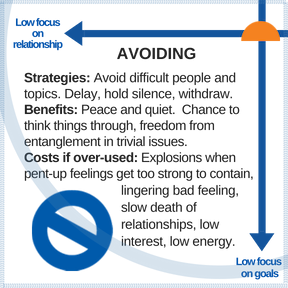
 When You Favor Avoiding in Storm
When You Favor Avoiding in Storm 
This suggests that, when stress and tension are high, you step back or withdraw in order to keep things calm. Avoiding has particular strengths and weaknesses that you should be aware of.
Avoiding has Important Uses
Strengths associated with wise use of this style include:
- Ability to stay out of needless battles over trivial issues not worth the time and energy consumed by confrontation.
- Calmness and stability.
- Conservation of time and energy.
- Caution in the face of risk. Avoiding allows for caution and planning. It gives space to think things through, pay attention to details, and count the cost before plunging into risky situations. Avoiders are not quick to jump into something new, but if their needs for forethought and careful procedure are addressed, they bring unusual reliability to implementing agreements that result.
But Don't Over-Use It
Each style has costs that come with over-reliance on that style. With Avoiding, these are not immediately obvious. Things may stay quiet for a while! But over-use of Avoiding has high long-term costs. These include:
- Paralysis or lack of resolution of important issues.
- Periodic explosions of pent-up anger. Avoiding does not resolve conflict; it only prevents confrontation. At a certain point, your anger may reach a level where you are no longer able to be silent and contain it. This can create "long stretches of cottony silence interrupted by periodic explosions", as one person described patterns in a conflict avoidant group.
- A residue of bad feelings that can poison the whole relationship, leading to...
- Slow death of relationships.
- Stagnation, dullness, declining interest and energy.
- Loss of engagement, trust, and accountability with others.
How to Maintain Balance with Avoiding
You can take steps to experience more benefits of wise use of Avoiding and fewer costs of overuse:
- Recognize conflict as an inevitable part of life that can in fact bring valuable results. There are many websites and books on skills for conflict resolution. See the section on Avoiding in the Free Web Resources page on our site for ideas. Studying these may increase your confidence that you can indeed talk about and resolve differences.
- Expand use of other styles so you are less likely to over-use Avoiding. Try Compromising - it shares a concern held by Avoiding not to prolong discussion over differences. Yet Compromising invests at least some effort in discussion and actively seeks a reasonable compromise.
- Approach important conversations and decisions in phases. Some Avoiders have a strong orientation towards examining details and understanding implications before committing to things. They are likely to say NO to anything requiring an immediate answer. If you recognize this in yourself, approach discussion in ways that turn this pattern into a strength. Request a several step approach to discussion:
First step, a discussion to identify the issues or problems.
Second step, study or think about the issue on your own.
Third step, return for a discussion with others. Know that other styles, particularly Directing, prefer immediate discussion and resolution, but will usually accept a phased approach if spelled out specifically - when, where, how long, etc. - Give yourself space to examine facts, details, precedents, etc., as part of a negotiation process.
- Read or take a course in assertiveness skills.
- Maintain personal disciplines of rest, reflection, quietness, journaling, etc. This helps all styles, and none more so than Avoiders.
Support Strategies for Avoiders

The most painful and time-consuming conflicts often come with those close to us, our partners and colleagues in life, work or organizations. Conflict style awareness can be a big help here, for if partners understand each other's style preferences they can avoid needless trouble over how to approach differences. This section is for partners who want to help you function at your best or for you in thinking through your preferences.
With someone who prefers Avoiding as a conflict style, others are more likely to get a favorable response if they:
- Stay low-key. When others are intense or demanding, an Avoider may avoid even more. Focus on creating safe space, not on goading an Avoider to engage.
- Give space and time to withdraw and think things through. More than other styles Avoiders need this.
- Move slowly, one step at a time. Haste in decision making can push Avoiders into withdrawal or analysis paralysis.
- Use a three-step approach. Others are more likely to get a "yes" answer from an Avoider with a "three-step" approach. First: Let an Avoider know - in a relaxed way - that a discussion is needed and request a time to have this. Second: Give time for the Avoider to think things through - an hour, a day, or a week. Third: Have the discussion.
- Provide information with time to review it. There is a subgroup of Avoiders who are task focused in a particular way: They bring caution and attention to detail to everything they do. They take care not to put important things at risk. They are reliable and consistent. These Avoiders need data and information, presented in a calm and methodical way, in order to comfortably enter negotiations. Others should make special efforts to provide them with relevant details, about plans, options, costs, rules, precedents from elsewhere, expected results, how surprises will be dealt with, etc. If possible, give time to absorb this information before expecting to negotiate. See also three-step approach in previous paragraph.
ESTILO PRESTATIVO EM ESTADO DE ESTRESSE
|
When You Favor Harmonizing in Storm
|
Harmonizing has Valuable Strengths
Characteristics of this style include:
- Flexible, adaptable, accommodating
- Sociable; gets along well with others.
- Easy-going and pleasant.
- Others feel value and respected.
- Sensitive to the needs to others.
- Gracious. Harmonizers make space for others and try to help them feel included and honored.
But Don't Over-Use It
If you over-use Harmonizing when other styles are more appropriate, it can bring consequences you should be aware of:
- Accumulation of resentment towards those you are trying to please, likely leading to...
- Reduced interest and enthusiasm on your part for relationships in which your needs are always overlooked;
- Depression, if your needs and opinions are never recognized
- Lack of direction or principle if you never take a stand on things important to you
- Failure to advocate for or protect others in your care
- Continuation of things that ought to be challenged.
Take Steps to Maintain Balance
You can take special measures so you experience more of the benefits of wise use of Harmonizing and fewer of the costs of overuse.
- Expand your use of other styles so you are less likely to over-use Harmonizing. Pay special attention to the Cooperating style, which draws on relational skills you already have but adds greater assertiveness about your own needs.
- Prepare for discussion by thinking through carefully what you value or need. Your relational orientation may make it difficult to think in the heat of difficult discussion. Thinking things through in advance will make it easier to hold out for things important to you.
- Strengthen assertiveness skills. With practice you can develop confidence in your ability to assert what you need without damaging relationships. Roleplaying these skills is particularly helpful in learning them.
- Create a Personal Mission Statement. People of all styles benefit from this, but creating a private written statement of your life's major purposes is likely to benefit you especially, by identifying personal anchors to stick to when others make demands.
- Create a small "reference council" of wise and trusted friends to consult with about a major conflict. Harmonizers seek strength in relationships. Be proactive about organizing time with people who will support you and help you to "stay the course" when necessary.
- Establish practices and routines of self-care. Stress and tension wear down everyone, but Harmonizers may be more vulnerable than others. When you have important negotiations, try to be well-rested, schedule frequent breaks, and keep discussions to a moderate length.
Support Strategies for Harmonizers

With someone who prefers Harmonizing as a conflict style, others are more likely to get a favorable response if they:
- Put relationship before task. Relationships always come before tasks for people who favor the Harmonizing style (the opposite of those who favor Directing). In work or negotiations with Harmonizers, use a two-step approach: 1) Begin on a light note and chit-chat for a few minutes, about the weekend, family, sports, etc. 2) Only then settle down to work or serious discussion.
- Make small gestures of friendship. Even more than other styles, Harmonizers appreciate a thoughtful note, a compliment, an offer of a something to drink, a well-chosen gift, a card, acknowledgement of work well done, etc. Harmonizers will go farther with you in following discussions or work if you first set the stage with such gestures.
- Talk about things in a way that is not angry or hostile. Keep your volume down and listen well. Do not exaggerate or dramatize your emotions, for the Harmonizer already hears and feels them at an amplified level.
- Keep it light. Harmonizers tune out of conversations that are long, heavy, and intense. Show a sense of humor, express appreciation, be positive.
- Invite disagreement or criticism. Since Harmonizers value relationships and hate offending anyone, they are not quick to speak their mind if they think others disagree. If you want a candid opinion, make it easier for a Harmonizer by letting them know you really want to hear what they think. And of course, don't betray your words by over-reacting.
- Avoid marathons. Harmonizers handle long discussions better if you take regular breaks and "lighten up" from time to time.
- Voice appreciation. Task-focused people who work with Harmonizers should make special effort to notice and appreciate the Harmonizers and their contributions.
As a Harmonizer you might want to pick out things above that seem true for you and discuss them with people you live or work with.
ESTILO CONCILIADOR EM ESTADO DE ESTRESSE
|
When You Favor Compromising in Storm
|
Compromising has Important Uses
Strengths associated with wise use of this pragmatic style include:
- Fairness and moderation. Compromisers don't push things to an extreme.
- Speed. An acceptable compromise can often be worked out fairly quickly.
- Familiarity. The idea that "you give a little, I'll give a little" is readily understood and brings out the best in people.
- Practicality. A compromise enables the show to go on.
But Don't Over-use It
Despite its valuable characteristics, Compromising has downsides. If you respond to every conflict with "let's make a deal", you will experience disappointments, including:
- Compromise of important principles or loss of important goals. There are situations where integrity requires you to take a firm stand and not to negotiate.
- Acceptance of half-solutions that don't address the real issues or that abandon too quickly the careful exploration required to come up with effective solutions.
- Wishy-washiness, a feeling that there are no red lines, no boundaries or principles.
- Difficulty in resolving future conflicts if there are no principles or goals to guide resolution of difficulties.
- Lost opportunities to engage others in in-depth conversation if you make a quick deal without looking deeply at things.
- Lack of commitment. Those involved may drag their feet at implementing solutions they don't fully support.
- Mediocre problem-solving skills that bring mediocre results. Quick compromises may hinder you from developing skills of in-depth problem analysis or prevent intense conversation necessary for building a deep relationship. Mediocre outcomes and lukewarm relationships may result.
Take Steps to Maintain Balance
These can help diversify your conflict resolution skills beyond Compromising:
- Expand your conflict style repertoire. Aim to be good at all styles.
- Pay special attention to Cooperating. The Cooperating style differs from Compromising in its greater willingness to remain in uncertainty for a time while exploring options. Is it important to get a quick solution? If not, Cooperating may be a better strategy since it is more likely to bring solutions that are creative and thorough.
- Consider sustainability of solutions. Does the compromise agreement address the real issues? Will key people support it? How will it feel a year from now?
- Consider values. Weigh whether compromise agreements are compatible with them.
Support Strategies for Compromisers

With someone who prefers Compromising as a conflict style, others are more likely to get a favorable response if they:
- Convey commitment to being fair, realistic, practical, moderate, reasonable. These matter to those who prefer the Compromising style. They respond well when, through actions or words, others bring these values into a conversation.
- Offer to back off from your own position. This is a familiar and respected move to the Compromiser, who will often reciprocate.
- Use a two-step approach. With a Compromiser, this means: 1) Describe honestly to the Compromiser what your first-choice solution would be; 2) Then indicate your openness to considering something mid-way between your first choice and the Compromiser's first choice.
- Wrap it up and move on. Compromisers have a practical orientation. Don't drag the discussion on and on. Tell the Compromiser what you want, find a middle point both of you can live with, and then get on with things. This is especially important to remember if you prefer Cooperating and probably have more tolerance for long discussion than the Compromiser.
LOW IN AVOIDING IN CALM 

This suggests that in early stages of conflict, when things are not yet emotional, you use Avoiding less than other styles. This spares you some of the weaknesses of Avoiding. For example, if people chronically avoid difficult discussion in a long-term partnership, bad feelings fester and grow. Energy and enthusiasm may fade. Too much avoidance endangers relationships.
But Avoiding also has important uses you may be missing out on. You'll be most effective in conflict if you are good at all five styles. So increased use of the arts of stepping back and avoiding conflict might be beneficial, especially if there is a gap of 3 points or more between your lowish Avoiding score and your highest score in Calm.
When to Avoid
In Avoiding, you respond to differences by withdrawing from interaction. Neither person gets what they want; you just avoid the topic or the person. Although it has limits, Avoiding is wise, and indeed necessary, at times.
Conflict takes time and energy, and it's stressful. If we take on every battle, we run out of time and energy for the things most important to us. We should avoid at times, especially when:
- The topic is too trivial to merit an argument.
- We have no time or energy to talk things through.
- The conflict is with someone we have no long-term relationship with. Why waste the energy?
- Key people are stressed or anxious. High stress reduces ability to think well and self-regulate emotions. Sometimes it is wise to delay till people have their best inner resources.
- When we are too weak to actively resist the demands of a more powerful party, yet need a passive form of resistance.
- When it might be dangerous physically or emotionally to get in an argument.
- When timing or sequence is wrong for discussion. Eg: Maybe a budget committee needs to meet before the property committee debates building plans.
- When we need time to think things through, gather more information, consult with others, etc., in preparation for discussion. Sometimes it is better to avoid discussion until we are ready for it.
Ideas for Strengthening your Ability to Avoid
Since Avoiding seems not to come naturally for you, your life may improve if you experiment with avoidance strategies. For example:
- Look before you leap into intense exchanges with people. Consider: 1) Whether you have the time and energy required to talk things through; 2) Whether the issue is worth the time and energy required.
- Dial back responsiveness. It's not necessary to accept every invitation to an argument. Experiment with simply sitting in thoughtful silence as others express views you disagree with. If silence is difficult for you, start by holding silence on something small, just for the practice of it.
- Delay or schedule conflict. For example, "Interesting idea, but could we talk about that some other time?" Or "Could I give you my views on that when we've got the time to really thresh it out?" Agree that certain topics are off-limit in certain times or places. Agree to discuss certain conflict-fraught topics, such as finances in a domestic partnership, on a regular basis, such as every second Saturday morning, but not at any other time.
- Learn verbal responses for Avoiding. Prepare and memorize diplomatic crutch phrases for Avoiding: "You know, I see it a bit differently, but I respect where you are coming from...." Or "I agree we need to discuss this, but could we set this topic aside until tomorrow morning so we can focus on other things right now?" Or "You see things one way and I see them a different way. Let's just leave it at that for now."
The styles you scored high in are valuable. Keep using them! But as you become more skilled in Avoiding, you may have more time and energy for the things you care about most.
LOW IN DIRECTING IN CALM 
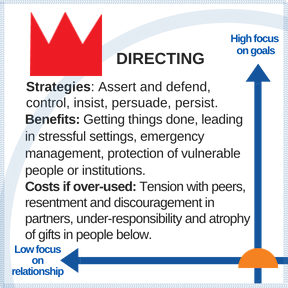
If you scored lower in Directing in Calm settings than other styles, you probably rarely use this style. This helps you avoid possible weaknesses of the Directing style, such as being inflexible or insensitive to relationships.
But Directing also has important strengths you may be missing out on. You'll be most effective in conflict if you are good at all five styles. So increased use of Directing might be beneficial, especially if the gap between your Directing score and your highest style in Calm is 3 or more.
In Directing you focus on your own wishes or duties. You ignore, while using this style, the wishes and feelings of others. Although it has obvious limits, Directing is necessary sometimes. A ship's captain in rough seas, an emergency room physician, the leader of a youth group on a field trip, the parent of a child running towards the street - all serve others best by being strongly in charge. They should not worry too much, at least for the moment, about the feelings and preferences of others.
When to Use Directing
Almost everyone needs to use Directing occasionally. It is valuable for:
- Asserting yourself and being heard;
- Setting limits or boundaries when others are acting inappropriately and not responsive to requests for cooperation;
- Taking a stand on principles that are being violated or defending others in need of protection.
- Exercising strong leadership and authority, giving instructions, setting limits, giving rapid coordination, without being distracted by those who may disagree.
- Emergency management. When lives and property depend on fast, decisive action, Directing is a gift. For this reason, police, military, and emergency services operate with Directing as the primary style of leadership.
How to Strengthen Directing
You can experiment with strategies that will make it easier to use Directing when you choose:
- Use purpose statements, which are concise statements of your priorities or intentions like "My purpose is...." or "What I'm trying to accomplish is...." When you have a clear, conscious focus on your purpose, you can more easily let others know what is required without being over-bearing.
- Focus more on your duties and roles in conflicts than you have in the past, and a little less on feelings and relationships. All of us face situations, especially in leadership, when our role requires us to do or say things that make certain people unhappy in order to avoid damage or unfairness to others.
- Recognize phases. We can't be all things all the time. Some moments require toughness; others generosity. With children, for example, adults know that sometimes we have to be strict. We tell a child to turn off the computer when it it late, and we shrug at the stormy response. But on a weekend, we may let the child have hours of screentime. When we have a clear understanding of where and how we seek to please others or work on relationships, it is easier to be firm when necessary.
- Pay attention to your physical presence. Strong body language and tone of voice help in pulling off a Directing response. If this is a challenge for you, ask someone you trust to give you feedback on how to strengthen your physical presence. Roleplay some conversations where you need to be strong.
- Careful with threats. Threats soon lose their impact if others see you don't follow through on them. If you must threaten consequences, size them well. Choose threats just big enough to have impact but small enough that you won't hesitate or fail to implement if necessary.
Ratchet up your use of Directing slowly and see how it feels. The styles you already use are valuable - keep using them! But start experimenting with Directing so you can use it when you must act decisively, take charge, coordinate, do difficult work, and persist in the face of big challenges or difficult people.
LOW IN COOPERATING IN CALM
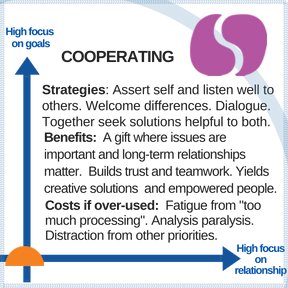
If you scored lower in this style in Calm settings than other styles, it suggests that in early stages of conflict, when it's just an everyday disagreement and things are not yet emotional, you use Cooperating less than other styles. This helps you avoid possible weaknesses of the Cooperating style, such as spending too much time and energy debating every small issue.
But Cooperating also has important strengths. If the gap between your Cooperating score in Calm and your highest score in another style in Calm is 3 points or more, you may be missing out on them. Conflict is easier if you are good at all five styles, so you may get quick gains with more use of this style.
Strengths of Cooperating
Cooperating is a "both...and..." response to conflict. You both assert your own needs and support your opponent by thoughtfully hearing and supporting their needs. Cooperating requires investing time and energy into conversation to look at the needs of both sides and seek ways to address both.
Although it's not right for all circumstances, Cooperating is wise and necessary at times:
- When you care deeply about a conflicted issue in a relationship that matters to you.
- Where keeping both sides happy is important.
- When significant truth exists in the views of both sides.
- When you seek a creative new solution that requires careful study of all sides of the situation.
- When you want to develop skills of problem analysis and problem solving that may strengthen your capacity in other areas as well.
- When you want to create a sense of teamwork, high morale, and confidence in taking on difficult issues.
- When you want to break out of dynamics of competition and wish to demonstrate ways of dealing with conflict that go beyond competition.
Improving Your Ability to Cooperate
Cooperating involves two sets of skills, asserting your own views and supporting your counterpart. Each set of skills requires some practice to learn in its own right. In the Cooperating conflict style you use them simultaneously. Because they have very differing qualities, these two skill sets may seem to be in tension with each other.
While you are still learning the skills, it helps to think of cooperating as taking turns. One side speaks while the other listens carefully. Then the other side speaks while the first listens.
Unless you were lucky enough to have good modeling of Cooperating by adults in your childhood, it may feel strange in the beginning. Expect to spend some time reading about and practicing this style to get good at it. A good place to start is with Lee Jay Berman's essay, "13 Tools for Resolving Conflict in the Workplace, with Customers and in Life". There are essays on this Riverhouse page (scroll to the section "Cooperating and Compromising as Conflict Styles") that offer many good ideas.
The styles you scored high in are valuable. Keep using them! But you may wish to experiment with getting more comfortable with Cooperating, especially in settings where you really care about both the relationship and the issues involved.
LOW IN COMPROMISING IN CALM 
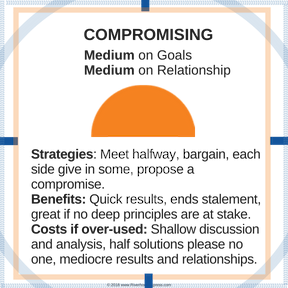
If you scored low in this style in Calm settings, this suggests that in early stages of conflict, when things are not yet emotional, you use Compromising less than other styles. This helps you avoid possible weaknesses of the Compromising style. These could include the compromise of important values or principles, failing to examine problems in depth, and settling for "half solutions" that don't really help anyone.
But Compromising also has important strengths you may be missing out on. You'll be most effective in conflict if you are good at all five styles. So increased use of Compromising might be beneficial, especially if the gap between your Compromising score and your highest score in Calm is 3 or more.
Benefits of Compromising
In Compromising, you seek prompt resolution of a conflict by finding a solution that gives both sides some of what they want but less than their full preference. You give in a bit in return for the other side giving in a bit. Compromising is not right for every situation, but it has strong advantages in some settings:
- Speed. An acceptable compromise can often be worked out fairly quickly.
- Familiarity. The idea that "you give a little, I'll give a little" seems reasonable and helps bring out the best in people.
- Fairness. It conveys a sense of principle and moderation.
- Practicality. A compromise enables things to move on.
Ideas for Expanding Use of Compromising
Experiment with the following to get better at compromising. None is perfect for all; pick the ones that appeal to you:
- Review the costs of conflict. Compromising brings realism to conflict resolution. A low score in Compromising suggests you may benefit if you pay more attention to the costs of conflict. This might help you accept "less than perfect" in order to resolve things and move on. If you scored high in Cooperating in Calm or Storm, this point is especially true, since you may then have instincts to just keep trying and trying, regardless to cost.
- Reduce the amount of time you give to discussing and processing. A big difference between Compromising and Cooperating is that the latter invests more time in discussion and examination of options. If you tend to spend a lot of time in long discussions, experiment with setting a time limit for working out a deal. This will shift you towards compromising.
- Review priorities. Consider what else is making claims on your time and energy, in addition to the issue in conflict. Look at the conflict in this context and ask yourself where is your time and attention most needed? Make conscious choices about the conflict to reflect those priorities.
- Lighten up a bit. Inability to compromise sometimes means people take every conflict as a survival test. What if you took yourself or your mission a little less seriously? What would happen if you'd smile and be mischievous?
- Expand your options; don't put all your eggs in one basket. Try to increase your alternatives for accomplishing the purposes you have in mind. This will make it easier to accept less than perfect solutions.
The other styles you scored high in are valuable - keep using them! But you may wish to experiment with getting more comfortable with Compromising, especially when a practical solution is needed on quickly; or when it is important for everyone to get at least some of what they wanted.
LOW IN HARMONIZING IN CALM 
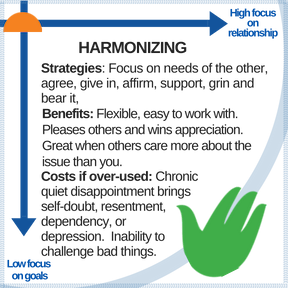
If you scored low in this style in Calm settings it suggests that in early stages of conflict, when it's just an everyday disagreement and things are not yet emotional, you use Harmonizing less than other styles. This helps you avoid possible weaknesses of the Harmonizing style, such as difficulty in taking a stand on things that matter to you, or inability to press ahead with important tasks if others challenge you.
But Harmonizing also has important strengths you may be missing out on. You'll be most effective in conflict if you are good at all five styles. So increased use of Harmonizing might be beneficial, especially if the gap between your lowish Harmonizing score and your highest score is 3 or more.
Benefits of Harmonizing
In Harmonizing, you give high priority to the relationship and keeping the other person happy, and a lower priority to tasks or your agenda. You set aside your own preferences as necessary in order to please the other person and keep the relationship strong. It's not right for all circumstances, but Harmonizing is a wise response sometimes. For example:
- When it's clear the other person cares a great deal more about getting their preferences than do you.
- When insisting on your own preferences will damage relationships that are important to you.
- To maintain a balance of give-and-take in a long-term partnerships. If a partner in work or life feels there is not a balance of give and take, they will resent it. You can help balance things by using Harmonizing responses more, especially on issues that are not so important.
- To bring warmth and joy to any long-term relationship.
Ways to Strengthen Your Use of Harmonizing
To Harmonize you give good attention and support to others and their needs. Ways to do that:
- Work on listening skills. Learn "Active Listening" or paraphrasing, and practice until you are good. When you listen well, harmonizing is easier.
- Lighten up. Slow down and inquire about others. Ask questions about things others are likely to enjoy talking about. Smile. Show a sense of humor. Build in some moments for chit-chat or relaxing along with serious discussion.
- Do conflict analysis from the perspective of your counterpart. As sympathetically as you can, make a list in private of your best guess as to the preferences, needs and challenges of a person you are in conflict with. Then look for ways to address them.
- Work on both task and relationship. If you scored low in Harmonizing in Calm, you are probably pretty task focused. To balance this, recognize two challenges in conflict: a) the tasks or issues the conflict is about; and b) the relationship. Make special efforts to support the relationship. For example...
- In negotiations, use a two-step approach. Unless your partner is also very task-oriented, consider using a two-step approach to establish a connection before serious work with others. First, connect as people by asking how they are doing, inquiring about a family member, thanking them for something, etc. Then, and only then, settle down to business.
You should continue to use the other styles too. But you may wish to experiment with getting more comfortable with Harmonizing, especially in relationships important to you or where connecting has been difficult.



 Need assistance? Email center@riverhouseepress.com with a copy of the login instructions you received and a brief description of what is happening. We'll reply in one business day-usually less.
Need assistance? Email center@riverhouseepress.com with a copy of the login instructions you received and a brief description of what is happening. We'll reply in one business day-usually less. 